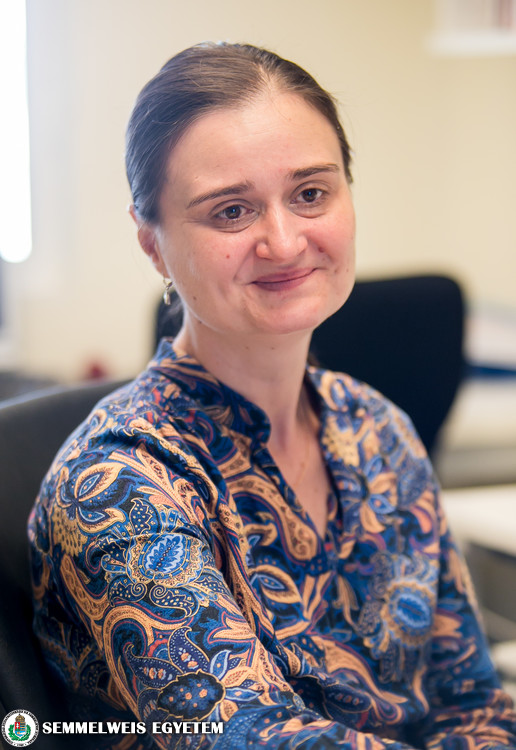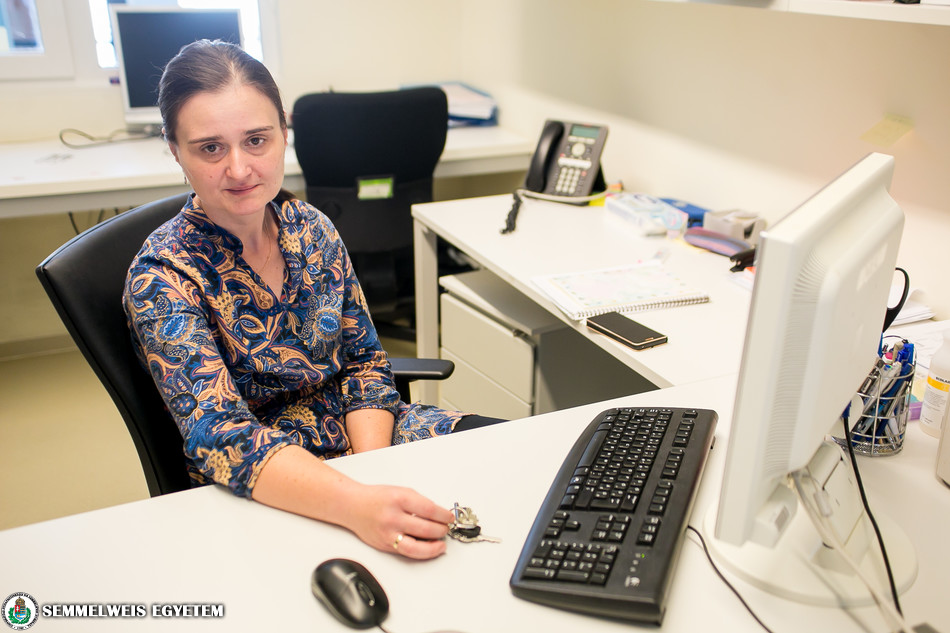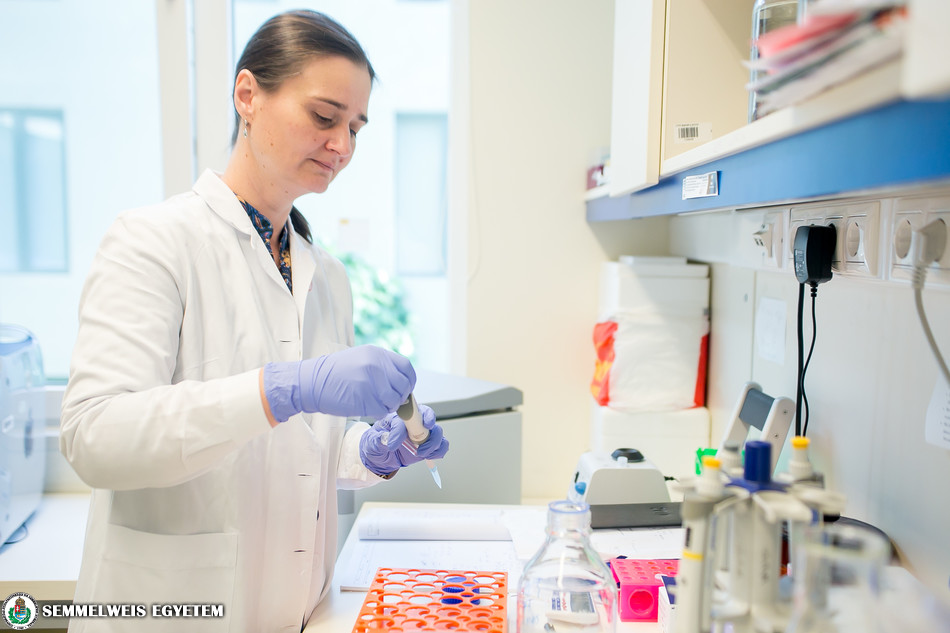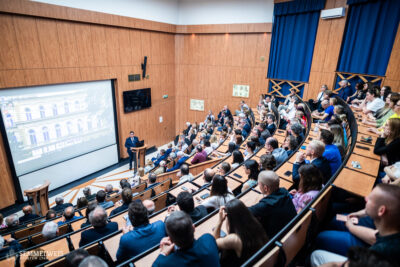Dr. Eszter Horváth, as senior lecturer at the university’s Department of Physiology, primarily studies the role of oxidative-nitrative stress in physiological and pathophysiological processes. The researcher, who has two children, had an opportunity to take part in active research already during her university years at an international study trip, which immediately had a lasting effect on her. Her research activity is complemented by her work as an educator, the love of which she got from her teacher parents.
 Physiology was always an exciting area for Dr. Eszter Horváth: already as a second-year student, she joined the work of the research lab at the Institute of Clinical Experimental Research and Human Physiology as a Students’ Scientific Association (TDK) student, where she mainly studied the interaction of nitrogen monoxide and prostanoids in regulating blood flow and microcirculation in the brain. Later her focus turned to the possibility of brain stem cell transplantation. As a fifth-year student, she had an opportunity to spend eight months in North Carolina under a study trip to the U.S., where the main focus of their research was whether the implantation of brain stem cells following brain trauma improves recovery, both on a tissue and on a functional level. This is where she first encountered the process of oxidative stress, which remains one of the main areas of her research to this day, she pointed out. She conducted research at a U.S. pharmaceutical research company for six months as a postdoctoral candidate, which again taught her a completely new way of thinking, she noted. For her third study trip, this time to New Jersey, her husband also accompanied her. She was pregnant at the time with her first child, who was later born in Hungary; she then spent two years at home with the baby, during which time she completed her PhD dissertation, she said. When her son was born, five years later, she left work only for a year, but she was already working as an active researcher at the time.
Physiology was always an exciting area for Dr. Eszter Horváth: already as a second-year student, she joined the work of the research lab at the Institute of Clinical Experimental Research and Human Physiology as a Students’ Scientific Association (TDK) student, where she mainly studied the interaction of nitrogen monoxide and prostanoids in regulating blood flow and microcirculation in the brain. Later her focus turned to the possibility of brain stem cell transplantation. As a fifth-year student, she had an opportunity to spend eight months in North Carolina under a study trip to the U.S., where the main focus of their research was whether the implantation of brain stem cells following brain trauma improves recovery, both on a tissue and on a functional level. This is where she first encountered the process of oxidative stress, which remains one of the main areas of her research to this day, she pointed out. She conducted research at a U.S. pharmaceutical research company for six months as a postdoctoral candidate, which again taught her a completely new way of thinking, she noted. For her third study trip, this time to New Jersey, her husband also accompanied her. She was pregnant at the time with her first child, who was later born in Hungary; she then spent two years at home with the baby, during which time she completed her PhD dissertation, she said. When her son was born, five years later, she left work only for a year, but she was already working as an active researcher at the time.
 The senior lecturer emphasized that in order for a family to function well and a career to be built, it is necessary to have a strong support system. Together with her husband, who is also a researcher, they help each other out in everything: if one of them has to spend more time on their work, then the other takes on a bigger role in the household and also spends more time with the kids. “When I am working on a problem all day, it is hard to put it down before I find a solution,” she said, admitting that in the evenings, after the kids have gone to sleep, she sometimes continues working.
The senior lecturer emphasized that in order for a family to function well and a career to be built, it is necessary to have a strong support system. Together with her husband, who is also a researcher, they help each other out in everything: if one of them has to spend more time on their work, then the other takes on a bigger role in the household and also spends more time with the kids. “When I am working on a problem all day, it is hard to put it down before I find a solution,” she said, admitting that in the evenings, after the kids have gone to sleep, she sometimes continues working.
According to Dr. Eszter Horváth, it is important in the workplace as well for a creative community to be built, where they are able to find solutions together to any difficulties that come up. During research, one sometimes does encounter dead ends, but there is always a new question whose study is more exciting than the pain caused by the failure of the previous one. She added that a negative result is a result too, and sometimes even this is what yields the most exciting outcome. She noted that she loves the variety that her work brings, and after some experiments, she is almost as giddy as a child when trying to find answers to scientific questions. In addition to research, she is also active as a teacher, and she said these two areas complement each other well, as the interest and enthusiasm of students gives her new strength, new momentum for her research.
During her years as a student, Dr. Horváth was a member of the Zalaegerszeg City Brass Band, where she played percussion instruments. Her love of music remains to this day, and she has passed this on to her daughter as well, so sometimes they even play together in the conservatory’s youth orchestra, which is a fantastic feeling, she said. In addition to music, her other great passion is ping-pong.
 Together with her co-workers, Dr. Eszter Horváth studies the role of oxidative-nitrative stress in physiological and pathophysiological processes. In collaboration with the 1st Department of Internal Medicine, they studied whether in the case of women with gestational diabetes, there were any signs of this in oxidative stress markers three years after birth. In cooperation with the Városmajor Heart and Vascular Center and the Department of Obstetrics and Gynecology, they are studying cardiovascular diseases and the role that oxidative stress plays in them. In their latest research, conducted in cooperation with the 1st Department of Pediatrics, they are studying the presence of the poly(ADP-ribose) polymerase enzyme, which is activated among others in inflammatory processes, in tissue samples taken from children suffering from Crohn’s disease. However, observations indicate that – as opposed to all other results – in the case of these Crohn’s patients the enzyme’s activity does not increase, rather it decreases, which may even play a role in the development of the disease, Dr. Horváth pointed out. She noted that this is a completely unexpected finding that could open new avenues in the study of this disease.
Together with her co-workers, Dr. Eszter Horváth studies the role of oxidative-nitrative stress in physiological and pathophysiological processes. In collaboration with the 1st Department of Internal Medicine, they studied whether in the case of women with gestational diabetes, there were any signs of this in oxidative stress markers three years after birth. In cooperation with the Városmajor Heart and Vascular Center and the Department of Obstetrics and Gynecology, they are studying cardiovascular diseases and the role that oxidative stress plays in them. In their latest research, conducted in cooperation with the 1st Department of Pediatrics, they are studying the presence of the poly(ADP-ribose) polymerase enzyme, which is activated among others in inflammatory processes, in tissue samples taken from children suffering from Crohn’s disease. However, observations indicate that – as opposed to all other results – in the case of these Crohn’s patients the enzyme’s activity does not increase, rather it decreases, which may even play a role in the development of the disease, Dr. Horváth pointed out. She noted that this is a completely unexpected finding that could open new avenues in the study of this disease.
Bernadett Bódi
Translation: Tamás Deme
Photo: Attila Kovács – Semmelweis University


